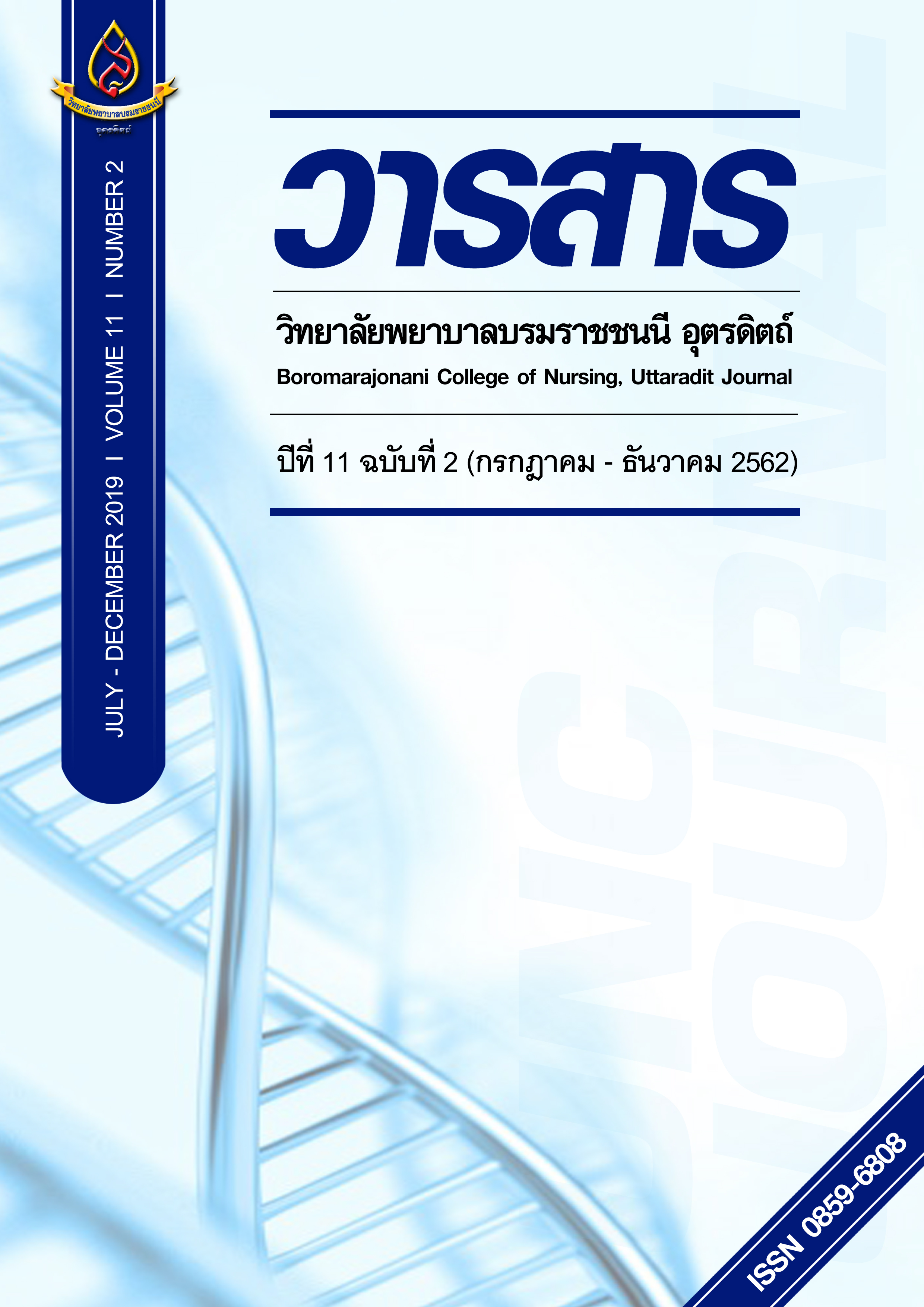ประสบการณ์การดูแลผู้สูงอายุติดบ้านโดยใช้รูปแบบภาคีเครือข่าย WE CAN DO by TIM
Main Article Content
บทคัดย่อ
การวิจัยเชิงปรากฏการณ์วิทยานี้เพื่อศึกษาประสบการณ์การดูแลผู้สูงอายุติดบ้านโดยใช้รูปแบบภาคีเครือข่าย WE CAN DO by TIM โดยศึกษาประสบการณ์ของจิตอาสา ผู้สูงอายุติดบ้าน ผู้ดูแลผู้สูงอายุ เจ้าหน้าที่องค์กรปกครองส่วนท้องถิ่น (อปท.) เจ้าหน้าที่โรงพยาบาลส่งเสริมสุขภาพตำบลและผู้ดำเนินโครงการการดูแลผู้สูงอายุติดบ้านโดยกระบวนการ WE CAN DO by TIM และกระบวนการมีส่วนร่วมของเครือข่ายในพื้นที่ จำนวน 20 คน เครื่องมือที่ใช้เป็นแบบสัมภาษณ์กึ่งโครงสร้าง โดยการสัมภาษณ์เชิงลึก วิเคราะห์ข้อมูลโดยใช้วิธีวิเคราะห์แก่นเนื้อหา (Thematic analysis) ผลการวิจัยพบว่า มีประเด็นหลัก (Theme) ดังนี้ 1) เปิดประสบการณ์ใหม่ ประกอบด้วยประเด็นรอง (subtheme) 2 ประเด็น คือ ต้องเข้าถึงหัวใจของรูปแบบและอยากเรียนรู้กระบวนการจากผู้วิจัยหลัก 2) เครือข่ายสันโค้งวัยใสส่งความสุข มี 2 ประเด็นย่อย คือ ความต้องการของชุมชน ผู้ให้และผู้รับมีความสุข 3) ผลลัพธ์ที่เกิดจากการใช้รูปแบบ ประกอบด้วย 2 ประเด็นรอง คือ ยิ่งทำยิ่งมีความสุข และ ผู้รับกลายเป็นผู้ให้ และ 4) ปัจจัยสำเร็จและอุปสรรคในการทำงาน
ผลการวิจัยทำให้เข้าใจ รูปแบบ WE CAN DO by TIM เป็นสิ่งที่ช่วยให้การดูแลผู้สูงอายุติดบ้านโดย ภาคีเครือข่ายมีส่วนร่วม สามารถปรับเปลี่ยนบทบาทจากการเป็นผู้รับมาเป็นจิตอาสาที่เป็นผู้ให้ ทำให้ผู้สูงอายุติดบ้านเปลี่ยนเป็นผู้สูงอายุที่มีส่วนร่วมช่วยเหลือสังคม
Article Details
บทความหรือข้อคิดเห็นใดใดที่ปรากฏในวารสารวิจัยการพยาบาลและวิทยาศาสตร์สุขภาพ เป็นวรรณกรรมของผู้เขียน ซึ่งบรรณาธิการหรือสมาคมศิษย์เก่า ไม่จำเป็นต้องเห็นด้วย และบทความที่ได้รับการตีพิมพ์เผยแพร่ถือเป็นลิขสิทธิ์ของวารสารวิจัยการพยาบาลและวิทยาศาสตร์สุขภาพ
เอกสารอ้างอิง
2) Anantakun, A. (nd.). Ageing society…Thailand challenge. Proposing to the Royal Institute and Members of the Thammasat and Political Parties , Office of the Royal Society (in press). (in Thai)
3) Department Of Provincial Administration, Ministry of Interior. (December 31, 2017). Statistics in the elderly of Thailand: 77 Provinces. http://www.dop.go.th/download/knowledge/th1533055363-125_1.pdf (in Thai)
4) Kim, W., Kreps, G. L., & Shin, C. N. (2015). The role of social support and social networks in health information-seeking behavior among Korean Americans: a qualitative study. International journal for equity in health, 14, 40. doi:10.1186/s12939-015-0169-8
5) Knodel,J., Teerawichitchainan,B., Prachuabmoh,V.,& Pothisiri,W. (2015). The situation of Thailand’s older population: An update based on the 2014 Survey of Older Persons in Thailand. Chiang Mai: Help Age International East Asia/Pacific Regional Office.
6) Oborn, E., Barrett, M., & Racko, G. (2013). Knowledge translation in healthcare: Incorporating theories of learning and knowledge from the management literature. Journal of Health Organization and Management, 27(4), 412 – 431.
7) Qiu, W. Q., Dean, M., Liu, T., George, L., Gann, M., Cohen, J., & Bruce, M. L. (2010). Physical and mental health of homebound older adults: an overlooked population. Journal of the American Geriatrics Society, 58(12), 2423-2428.
8) Ryff C.D. (2014). Psychological Well-Being Revisited: Advances in Science and Practice. Psychotherapy and Psychosomatics, 83(1): 10–28. doi:10.1159/000353263.
9) Saengtong, J.(2017). Aging society (Complete aged): The elderly condition of good quality. Rusamilae Journal, 38(1),1-28. (in Thai)
10) Stetler, C.B. (2001). Updating the Stetler Model of Research Utilization to facilitate Evidence-
Based Practice. Nursing Outlook, 49, 272-279.
11) Sudsawad, P. (2007). Knowledge translation: Introduction to models, strategies, and measures. Austin, TX: Southwest Educational Development Laboratory, National Center for the Dissemination of Disability Research (NCDDR).
12) Sunsern, R. (2012). Community-based rehabilitation: A principle strategy for support people with disabilities. Journal of Nursing and Education, 5(1), 2-11. (in Thai)
13) Sunsern, R., Photong, J., Rakkoamsuk, S., Lawang, W., & Timsuwan, B. (2012). Development of partnership networking for caring people with physical disabilities in the community: WE CAN DO by TIM process. Journal of Nursing and Education, 5(3), 17-36. (in Thai)
14) Wei Qo, Michael D, Timothy L, Linda G, Margery G, Joshua C, & Martha L. (2010). Physical and Mental Health of the Homebound Elderly: An Overlooked Population. Journal of the American Geriatrics Society, 58(12), 2423–2428.
15) WHO. (2006). Bridging the “Know–Do” gap meeting on knowledge translation in global health. WHO Document Production Services, Geneva, Switzerland.
16) WHO. (2015). World report on ageing and health. WHO Document Production Services, Geneva, Switzerland.
Wittayawuttikul, R. & Wipawin, N. (2012). Social Network Analysis (SNA) for Information Science Research. Journal of Library and Information Science, 5(2), 128-140. (in Thai)
17) Wong, P., Liamputtong, P., Koch,S. & Rawson,H.(2019). The impact of social support networks on family resilience in an Australian Intensive Care Unit: A constructivist grounded theory. Journal of Nursing Scholarship, 51(1), 68–80.


